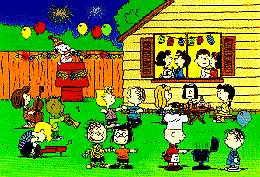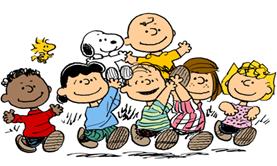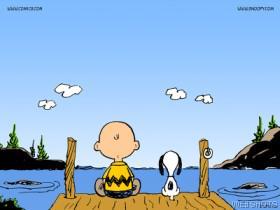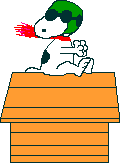Charles
Schultz Philosophy

 The following is the philosophy of Charles Schultz,
the creator of the "Peanuts" comic strip.
The following is the philosophy of Charles Schultz,
the creator of the "Peanuts" comic strip.
You don't have to actually answer the questions.
Just read the e-mail straight through, and you'll get the point.
1. Name the five wealthiest people in
the world.
2. Name the last five Heisman trophy winners.
3. Name the last five winners of the Miss America.
4. Name ten people who have won the Nobel or
Pulitzer Prize.
5. Name the last half dozen Academy Award winner
for best actor and actress.
6. Name the last decade's worth of World Series
winners.
How did you do?
The point is, none of us remember the headliners
of yesterday. These are no second-rate achievers. They are the best in
their fields. But the applause dies. Awards tarnish. Achievements are forgotten.
Accolades and certificates are buried with their owners .
Here's another quiz. See how you do on this one:
1. List a few teachers who aided your
journey through school.
2. Name three friends who have helped you through
a difficult time.
3. Name five people who have taught you something
worthwhile.
4. Think of a few people who have made you feel
appreciated and special.
5. Think of five people you enjoy spending time
with.
Easier?

 The lesson:
The lesson:
The people who make a difference in your life
are not the ones with the most credentials, the most money, or the most
awards. They are the ones that care .
 Pass this on to those people who have made a difference
in your life.
Pass this on to those people who have made a difference
in your life.
"Don't worry about the world coming to an end
today. It's already tomorrow in Australia."
(Charles Schultz)




Here
is a math trick that might get you thinking...
1. Grab a calculator.
2. Key in the first three digits of your phone
number (NOT the area code)
3. Multiply by 80
4. Add 1
5. Multiply by 250
6. Add the last 4 digits of your phone number
7. Add the last 4 digits of your phone number
again.
8. Subtract 250
9. Divide number by 2
Do you recognize the answer?


above used in zine 19
COMPUTER OF THE FUTURE


This pen-shaped
computer produces both the monitor as well as the keyboard on flat
surfaces
from where you can just carry out the normal operations you do on your
desktop.
THE ANNUAL DARWIN AWARDS
According to police in Windsor, Ontario, Daniel Kolta, 27, and Randy
Taylor, 33, died in a head-on collision, thus earning a tie in the game
of chicken they were playing with their Snowmobiles.
In Detroit, a 41-year-old man got stuck and drowned in two feet of water
after squeezing head first through an 18-inch-wide sewer grate to retrieve
his car keys.
A 49-year-old San Francisco stockbroker, who "totally zoned when he
ran," accidentally jogged off a 100-foot-high cliff on his daily run.
Buxton, NC: A man died on a beach when an 8-foot-deep hole he had dug
into the sand caved in as he sat inside it. Beach-goers said Daniel Jones,
21, dug the hole for fun, or protection from the wind, and had been sitting
in a beach chair at the bottom Thursday afternoon when it collapsed, burying
him beneath 5 feet of sand. People on the beach, on the outer banks, used
their hands and shovels, trying to claw their way to Jones, a resident
of Woodbridge, VA, but could not
reach him. It took rescue workers using heavy equipment almost an hour
to free him while about 200 people looked on. Jones was pronounced dead
at a hospital.
Santiago Alvarado, 24, was killed in Lompoc, CA, as he fell face-first
through the ceiling of a bicycle shop he was burglarizing. Death was caused
when the long flashlight he had placed in his mouth (to keep his hands
free) rammed into the base of his skull as he hit the floor.
According to police in Dahlonega, GA, ROTC cadet Nick Berrena, 20, was
stabbed to death in January by fellow cadet Jeffrey Hoffman, 23, who was
trying to prove that a knife could not penetrate the flak vest Berrena
was wearing.
Sylvester Briddell, Jr., 26, was killed in Selbyville, Del, as he won
a bet with friends who said he would not put a revolver loaded with four
bullets into his mouth and pull the trigger.
Honorable Mention (only because they lived): In Guthrie, Okla, in October,
Jason Heck tried to kill a millipede! with a shot from his .22 caliber
rifle, but the bullet ricocheted off a rock near the hole and hit his pal
Antonio Martinez in the head, fracturing his skull.
In Elyria, Ohio, in October, Martyn Eskins, attempting to clean out
cobwebs in his basement, declined to use a broom in favor of a propane
torch and caused a fire that burned the first and second floors of his
house.
Paul Stiller, 47, was hospitalized in Andover Township, NJ, and his
wife Bonnie was also injured, when a quarter-stick of dynamite blew up
in their car. While driving around at 2 AM, the bored couple lit the dynamite
and tried to toss it out the window to see what would happen, but apparently
failed to notice the window was closed.
Runner Up (again, only because their best efforts to kill themselves
weren't quite good enough): TACOMA, WA Kerry Bingham had been drinking
with several friends when one of them said they knew a person who had bungee-jumped
from the Tacoma Narrows Bridge in the middle of traffic. The conversation
grew more heated and at least 10 men trooped along the walkway of the bridge
at 4:30 am. Upon arrival at the midpoint of the bridge they discovered
that no one had brought a bungee rope. Bingham, who had continued drinking,
volunteered and pointed out that a coil of lineman's cable lay nearby.
One end of the cable was secured around Bingham's leg and the other end
was tied to the bridge. His fall lasted 40 feet before the cable tightened
and tore his foot off at the ankle. He miraculously survived his fall into
the icy river water and was rescued by two nearby fishermen. "All I can
say," said Bingham, "is that God was watching out for me on that night.
There's just no other explanation for it." Bingham's foot was never located.
And The Winner: Overzealous zookeeper Friedrich Riesfeldt (Paderborn,
Germany) fed his constipated elephant Stefan 22 doses of animal laxative
and more than a bushel of berries, figs and prunes before the plugged-up
pachyderm finally let it fly, and suffocated the ? keeper under 200 pounds
of poop! Investigators say ill-fated Friedrich, 46, was attempting to give
the ailing elephant an olive oil enema when the relieved beast unloaded
on him. "The sheer force of the elephant's unexpected defecation knocked
Mr. Riesfeldt to the ground, where he struck his head on a rock and lay
unconscious as the elephant continued to evacuate his bowels on top of
him," said flabbergasted Paderborn police detective Erik Dern. With no
one there to help him, he lay under all that dung for at least an hour
before a watchman came along, and during that time he suffocated. It seems
to be just one of those freak accidents that proves that "Shit Happens."
Computer games 'do have benefits'
Computer games can aid children's health and do not deserve a
wholly negative reputation, an expert says.
BBC
News ~ July 15, 2005
Mark Griffiths, professor of gambling studies at Nottingham Trent University,
says they can be a distraction for children undergoing painful treatment.
Writing in the British Medical Journal, he added that games can also help
children with attention deficit disorders gain social skills.
But he said violent games, like violent films, might fuel aggression
in some. You can't tar all games with the same brush
Professor Mark Griffiths, Nottingham Trent University However, Professor
Griffiths said this group could be prone to aggression, which could have
been triggered by other factors such as witnessing violence in the home
or seeing it on TV.
After 15 years of research into video games, Professor Griffiths said
he wanted to redress the balance of public perception of their effects.
He said games could be used as a very powerful form of distraction for
children undergoing painful treatments. Professor Griffiths pointed to
studies which had shown children undergoing chemotherapy and treatment
for sickle cell anaemia had benefited from being given games to distract
then. He said they needed less pain relief and had less nausea and lower
blood pressure than those who were simply told to rest after their treatments.
'Trivialised'
Professor Griffiths also highlighted specific cases where video games
had been used to help treat specific physical conditions, including an
eight-year-old boy whose illness caused him to pick his lip, causing scarring.
Previous treatments had failed so the boy was given a hand-held video game
to keep his hands occupied. Two weeks later the affected area had healed.
Computer games have even been used as a form of physiotherapy for arm
injuries Professor Griffiths told the BBC News website: "You can't tar
all games with the same brush. "Video gaming is safe for most players and
can be useful in healthcare. "Although playing video games is one of the
most popular leisure activities in the world, research into its effects
on players, both positive and negative, is often trivialised." He added:
"On balance, there is little evidence that moderate frequency of play has
serious adverse effects, but more evidence is needed on excessive play
and on defining what constitutes excess in the first place. "There should
also be long-term studies of the course of video game addiction."
'Scapegoat'
He said it was possible games could fuel violence in some. But he added:
"It is not possible to say what is cause and effect. These could be aggressive
individuals who sought out these games. "And aggression could stem from
seeing violence on TV or in the home."
Dr Guy Cumberbatch, head of the independent Communications Research
Group in the UK, agreed with the editorial's conclusions. "Video games
are always used as a scapegoat for concerns. There's no doubt that many
games are found to be offensive by many. But there are many media forms,
films or TV programmes, where that is the case."
101 THINGS YOU CAN DO
THE FIRST THREE WEEKS OF CLASS
By
Joyce T. Povlacs ~ Teaching and Learning Center, University of Nebraska-Lincoln
Introduction
Beginnings are important. Whether the class is a large introductory
course for freshmen or an advanced course in the major field, it makes
good sense to start the semester off well. Students will decide very early
- some say the first day of class - whether they will like the course,
its contents, the teacher, and their fellow students.
The following list of "101 Things You Can Do..." is offered in the spirit
of starting off right. It is a catalog of suggestions for college teachers
who are looking for a fresh way of creating the best possible environment
for learning. Not just the first day, but the first three weeks of a course
are especially important, studies say, in retaining capable students. Even
if the syllabus is printed and lecture notes are ready to go in August,
most college teachers can usually make adjustments in teaching methods
as the course unfolds and the characteristics of their students become
known.
These suggestions have been gathered from UNL professors and from college
teachers elsewhere. The rationale for these methods is based on the following
needs: 1) to help students make the transition from high school and summer
or holiday activities to learning in college; 2) to direct students' attention
to the immediate situation for learning - the hour in the classroom: 3)
to spark intellectual curiosity - to challenge students; 4) to support
beginners and neophytes in the process of learning in the discipline; S)
to encourage the students' active involvement in learning; and 6)
to build a sense of community in the classroom.
Ideas For the First Three Weeks:
Here, then, are some ideas for college teachers for use in their courses
as they begin a new semester.
Helping Students Make Transitions
1. Hit the ground running on the
first day of class with substantial content.
2. Take attendance: roll
call, clipboard, sign in, seating chart.
3. Introduce teaching assistants
by slide, short presentation, or self-introduction.
4. Hand out an informative, artistic,
and user-friendly syllabus.
5. Give an assignment on the
first day to be collected at the next meeting.
6. Start laboratory experiments
and other exercises the first time lab meets.
7. Call attention (written and
oral) to what makes good lab practice: completing work to be done,
procedures, equipment, clean up, maintenance, safety, conservation of supplies,
full use of lab time.
8. Administer a learning style
inventory to help students find out about themselves.
9. Direct students to the Learning
Skills Center for help on basic skills.
10. Tell students how much time they
will need to study for this course.
11. Hand out supplemental study aids:
library use, study tips, supplemental readings and exercises.
12. Explain how to study for
kind of tests you give.
13. Put in writing a limited number
of ground rules regarding absence, late work, testing procedures,
grading, and general decorum, and maintain these.
14. Announce office hours frequently
and hold them without fail.
15. Show students how to handle learning
in large classes and impersonal situations.
16. Give sample test questions.
17. Give sample test question answers.
18. Explain the difference between legitimate
collaboration
and academic dishonesty; be clear when collaboration is wanted and
when it is forbidden.
19. Seek out a different student
each day and get to know something about him or her.
20. Ask students to write about what
important things are currently going on in their lives.
21 .Find out about students' jobs;
if they are working, how many hours a week, and what kinds of jobs they
hold.
Directing Students' Attention
22. Greet students at the door
when they enter the classroom.
23. Start the class on time.
24. Make a grand stage entrance to
hush a large class and gain attention.
25. Give a pre-test on the day's
topic.
26. Start the lecture with a
puzzle, question, paradox, picture, or cartoon on slide or transparency
to focus on the day's topic.
27. Elicit student questions and
concerns at the beginning of the class and list these on the chalkboard
to be answered during the hour.
28. Have students write down what they
think the important issues or key points of the day's lecture will
be.
29. Ask the person who is reading the
student newspaper what is in the news today.
Challenging Students
30. Have students write out their
expectations for the course and their own goals for learning.
31. Use variety in methods of presentation
every class meeting.
32. Stage a figurative "coffee break"
about twenty minutes into the hour; tell an anecdote, invite students
to put down pens and pencils, refer to a current event, shift media.
33. Incorporate community resources:
plays, concerts, the State Fair. government agencies. businesses, the outdoors.
34. Show a film in a novel way:
stop it for discussion, show a few frames only, anticipate ending, hand
out a viewing or critique sheet, play and replay parts.
35. Share your philosophy of teaching
with your students.
36. Form a student panel to present
alternative views of the same concept.
37. Stage a change-your-mind debate.
with students moving to different parts of the classroom to signal change
in opinion during the discussion.
38. Conduct a "living" demographic
survey by having students move to different parts of the classroom:
size of high school. rural vs. urban, consumer preferences...
39. Tell about your current research
interests and how you got there from your own beginnings in the discipline.
40. Conduct a role-play to make a
point or to lay out issues.
41. Let your students assume the
role of a professional in the discipline: philosopher, literary critic,
biologist, agronomist, political scientist, engineer.
42. Conduct idea-generating or brainstorming
sessions to expand horizons.
43. Give students two passages of material
containing alternative views to compare and contrast.
44. Distribute a list of the unsolved
problems. dilemmas. or great questions in your discipline and invite
students to claim one as their own to investigate.
45. Ask students what books they've
read recently.
46. Ask what is going on in government
on this subject which may affect their future.
47. Let your students see the enthusiasm
you have for your subject and your love of learning.
48. Take students with you to hear
guest speakers or special programs on campus.
49. Plan "scholar-gypsy" lesson
or unit which shows students the excitement of discovery in your discipline.
Providing Support
50. Collect students' current telephone
numbers and addresses and let them know that you may need to reach
them.
51. Check out absentees. Call
or write a personal note.
52. Diagnose the students' prerequisites
learning by questionnaire or pre-test ant give them the feedback as
soon as possible.
53. Hand out study questions or study
guides.
54. Be redundant. Students should
hear, read. or see key material at least three times.
55. Allow students to demonstrate
progress in learning: summary quiz over the day's work. a written reaction
to the day's material.
56. Use non-graded feedback to
let students know how they are doing: post answers to ungraded quizzes
and problem sets, exercises in class, oral feedback.
57. Reward behavior you want:
praise, stars, honor roll, personal note.
58. Use a light touch: smile, tell
a good joke, break test anxiety with a sympathetic comment.
59. Organize. Give visible structure
by posting the day's "menu" on chalk- board or overhead.
60. Use multiple media: overhead,
slides, film, videotape, audio tape, models, sample material.
61. Use multiple examples, in
multiple media. to illustrate key points and . important concepts.
62. Make appointments with all students
(individually or in small groups).
63. Hand out wallet-sized telephone
cards with all important telephone numbers listed: office department,
resource centers, teaching assistant, lab.
64. Print all important course dates
on a card that can be handed out and taped to a mirror.
65. Eavesdrop on students before
or after class and join their conversation about course topics.
66. Maintain an open lab gradebook.
with grades kept current. during lab time so that students can check their
progress.
67. Check to see if any students
are having problems with any academic or campus matters and direct
those who are to appropriate offices or resources.
68. Tell students what they need
to do to receive an "A" in your course.
69. Stop the work to find out what
your students are thinking feeling and doing in their everyday lives.
Encouraging Active Learning
70. Have students write something.
71.Have students keep three-week-three-times-a-week
journals in which they comment. ask questions. and answer questions
about course topics.
72. Invite students to critique each
other's essays or short answer on tests for readability or content.
73. Invite students to ask questions
and
wait for the response.
74. Probe student responses to
questions ant wait for the response.
75. Put students into pairs or "learning
cells" to quiz each other over material for the day.
76. Give students an opportunity to
voice opinions about the subject matter.
77. Have students apply subject matter
to solve real problems.
78. Give students red, yellow, and green
cards (made of posterboard) and periodically call for a vote on
an issue by asking for a simultaneous show of cards.
79. Roam the aisles of a large
classroom and carry on running conversations with students as they work
on course problems (a portable microphone helps).
80. Ask a question directed to one
student and wait for an answer.
81. Place a suggestion box in
the rear of the room and encourage students to make written comments every
time the class meets.
82. Do oral show of-hands multiple
choice tests for summary review and instant feedback.
83. Use task groups to accomplish
specific objectives.
84. Grade quizzes and exercises
in class as a learning tool.
85. Give students plenty of opportunity
for practice before a major test.
86. Give a test early in the semester
and return it graded in the next class meeting.
87. Have students write questions
on index cards to be collected and answered the next class period.
88. Make collaborate assignments
for several students to work on together.
89. Assign written paraphrases and
summaries of difficult reading.
90. Give students a take-home problem
relating to the days lecture.
91. Encourage students to bring current
news items to class which relate to the subject matter and post these
on a bulletin board nearby.
Building Community
92. Learn names. Everyone makes
an effort to learn at least a few names.
93. Set up a buddy system so
students can contact each other about assignments and coursework.
94. Find out about your students
via questions on an index card.
95. Take pictures of students
(snapshots in small groups, mug shots) and post in classroom, office, or
lab.
96. Arrange helping trios of students
to assist each other in learning and growing.
97. Form small groups for getting
acquainted; mix and form new groups several times.
98. Assign a team project early in
the semester and provide time to assemble the team.
99. Help students form study groups
to operate outside the classroom.
100. Solicit suggestions from students
for outside resources and guest speakers on course topics.
Feedback on Teaching
101. Gather student feedback in the first
three weeks of the semester to improve teaching and learning.
HOW SMART IS YOUR RIGHT FOOT?
Just try this. It is from an orthopedic surgeon...
This will boggle your mind and you will keep trying over and over again
to see if you can outsmart your foot,but, you can't.
It's pre-programmed in your brain!
1. WITHOUT anyone watching you (they will think you are GOOFY......)
and while sitting where you are at your desk in front of your computer,
lift your right foot off the floor and make clockwise circles.
2. Now, while doing this, draw the number "6" in the air with your
right hand. Your foot will change direction.
I told you so!!! And there's nothing you can do about it!
A's are common as dirt in universities
nowadays because
it's almost impossible for a professor to grade honestly.
National Trends in Grade Inflation
Where
All Grades Are Above Average
A's
For Everyone
TIME: Imagine there is a bank that credits your account
each morning with 86,400
http://www.scottstratten.com/movie.html
CANADIAN BEAVER FACTS
The Beaver - our national animal symbol. Intelligent, resourceful,
family-minded and hard-working; they’re a lot like Canadians themselves:
-
Next to the capybara, the beaver is the 2nd largest living rodent in the
world– up to 35 kg (75 lbs).
-
Beavers are 90—120 cm (3 - 4 ft) long including their 30 cm (12 in) tail,
and about 38 cm (15 in) high at the shoulder.
-
Once considered the most valuable of furs, trapping of beavers caused their
extermination over a large part of their range.
-
Beavers build homes called lodges up to 90 cm (3 ft) high and 1.5 m (5
ft) wide made from branches and trees, mud, crop residue and stones. The
entrances are below water level, with ramps leading to the living quarters,
located on a platform above water level. They may also build burrows in
banks with underwater entrances.
-
The beaver's large front teeth or incisors protrude in front of their lips,
enabling them to cut and chew submerged wood without getting water in their
mouths. And they never stop growing, so they must gnaw, chew, and chop
nearly all the time.
-
Excellent swimmers, a beaver can stay underwater for up to fifteen minutes
and are capable of traveling nearly 1/2 mile before it must surface for
more air. Beaver’s noses and ears have valves that close when they submerge.
-
When alarmed, a beaver slaps the water with its tail, making a loud noise
that sends other beavers hurrying to the safety of deep water.
-
The instinct to build dams is a reaction to the sound of running water.
This ‘urge’ has created many of the woodland ponds that support lush vegetation
and eventually become meadows.
“(Hockey) Half the game is mental; the other half
is being mental.” ~ Jim McKenny
“I don't have a bank account because I don't know my mother's maiden
name.” ~ Paula Poundstone
“Ninety percent of putts that are short, don't go in.” ~ Yogi Berra
“My mother had a great deal of trouble with me, but I think she enjoyed
it.” ~ Mark Twain
DEPRESSING
TUNES
What do Pink Floyd, Bette Midler
and Metallica have in common? They've all written horribly depressing tunes,
according to Tom Reynolds, author of I Hate Myself and Want to Die. He
offers his top 25 miserable tracks.
25. Sam Stone John Prine (1972)
24. My Immortal Evanescence (2002)
23. You don't bring me flowers Neil Diamond &
Barbra Streisand (1978)
22. The River Bruce Springsteen (1980)
21. Tell Laura I love her Ray Peterson (1960)
20. All By Myself Celine Dion (1996)
19. Woman's Prison Loretta Lynn (2004)
18. Prayers for Rain The Cure (1989)
16. The Rose Bette Midler (1980)
15. Maggie's Dream Don Williams (1984)
14. Comfortably Numb Pink Floyd (1979)
13. Brick Ben Folds Five (1997)
12. Ruby, Don't take your love to town Kenny
Rogers and the First Edition (1969)
11. One Metallica (1988)
10. People Who Died The Jim Carroll Band (1980)
9. Sister Morphine Marianne Faithfull (1979)
8. Hurt Nine Inch Nails (1994)
7. Strange Fruit Billie Holiday (1939)
6. DOA Bloodrock (1971)
5. Seasons in the Sun Terry Jacks (1974)
4. Total Eclipse of the Heart Bonnie Tyler (1984)
3. Honey Bobby Goldsboro (1968)
2. The Shortest Story Harry Chapin (1976)
1. The Christmas Shoes Newsong (2000)
A
Tale of Six Boys
Each year I am hired to go to Washington,
DC, with the eighth grade class from Clinton, WI, where I grew up, to videotape
their trip. I greatly enjoy visiting our nation's capitol, and each year
I take some special memories back with me. This fall's trip was especially
memorable.
On the last night of our trip, we stopped
at the Iwo Jima memorial This memorial is the largest bronze statue in
the world and depicts one of the most famous photographs in history --
that of the six brave soldiers raising the American Flag at the top of
a rocky hill on the island of Iwo Jima, Japan, during WW II.
Over one hundred students and chaperones
piled off the buses and headed towards the memorial. I noticed a solitary
figure at the base of the statue, and as I got closer he asked, "Where
are you guys from?"
I told him that we were from Wisconsin
"Hey, I'm a cheese head, too! Come gather around, Cheese heads, and I will
tell you a story." (James Bradley just happened to be in Washington,
DC, to speak at the memorial the following day).
He was there that night to say good night
to his dad, who
has since passed away. He was just about
to leave when he saw the buses pull up. I videotaped him as he spoke to
us, and received his permission to share what he said from my videotape.
It is one thing to tour the incredible monuments filled with history in
Washington, D.C., but it is quite another to get the kind of insight we
received that night.)
When all had gathered around, he reverently
began to speak. (Here are his words that night.)
"My name is James Bradley and I'm
from Antigo, Wisconsin. My dad is on that statue, and I just wrote a book
called 'Flags of Our Fathers' which is #5 on the New York Times Best Seller
list right now. It is the story of the six boys you see behind me.
Six boys raised the flag. The first guy
putting the pole in the ground is Harlon Block. Harlon was an all-state
football player. He enlisted in the Marine Corps with all the senior members
of his football team. They were off to play another type of game A game
called 'War.' But it didn't turn out to be a game.
Harlon, at the age of 21, died with
his intestines in his hands. I don't say that to gross you out, I say that
because there are people who stand in front of this statue and talk about
the glory of war. You guys need to know that most of the boys in Iwo Jima
were 17, 18, and 19 years old.
(He pointed to the statue) "You see this
next guy? That's Rene Gagnon from New Hampshire. If you took Rene's
helmet off at the moment this photo was taken and looked in the webbing
of that helmet, you would find a photograph. A photograph of his
girlfriend. Rene put that in there for
protection because he was scared. He was 18 years
old. Boys won the battle of Iwo Jima. Boys. Not old men.
"The next guy here, the third guy in this
tableau, was Sergeant Mike Strank. Mike is my hero. He was the hero of
all these guys. They called him the "old man" because he was so old. He
was already 24. When Mike would motivate his boys in training camp, he
didn't say, 'Let's go kill some Japanese' or 'Let's die for our country'
He knew he was talking to little boys. Instead he would say, 'You do what
I say, and I'll get you home to your mothers.'
"The last guy on this side of the statue
is Ira Hayes, a Pima Indian from Arizona. Ira Hayes walked off Iwo Jima.
He went to the White House with my dad. President Truman told him, 'You're
a hero.' He told reporters, 'How can I feel like a hero when 250 of my
buddies hit the island with me and only 27 of us walked off alive?
So you take your class at school, 250 of you spending
a year together having fun, doing everything together. Then all 250 of
you hit the beach, but only 27 of your classmates walk
off alive. That was Ira Hayes. He had images
of horror in his mind. Ira Hayes died dead drunk, face down at the age
of 32 .. ten years after this picture was taken.
"The next guy, going around the statue,
is Franklin Sousley from Hilltop, Kentucky. A fun-lovin' hillbilly boy.
His best friend, who is now 70, told me, 'Yeah, you know, we took two cows
up on the porch of the Hilltop General Store. Then we strung wire across
the stairs so the cows couldn't get down. Then we fed them Epsom salts.
Those cows crapped all night. Yes,
he was a fun-lovin' hillbilly boy. Franklin died
on Iwo Jima at the age of 19.
When the telegram came to tell his mother that
he was dead, it went to the Hilltop General Store. A barefoot boy ran that
telegram up to his mother's farm. The neighbors could hear her scream all
night and into the morning. The neighbors lived a quarter of a mile away.
"The next guy, as we continue to go around
the statue, is my dad, John Bradley from Antigo, Wisconsin, where I was
raised. My dad lived until 1994, but he would never give interviews.
When Walter Cronkite's producers, or the
New York Times would call, we were trained as little kids to say, 'No,
I'm sorry, sir, my dad's not here. He is in Canada fishing. No, there is
no phone there, sir. No, we don't know when he is coming back.' My dad
never fished or even went to Canada. Usually, he was sitting there right
at the table eating his Campbell's soup. But we had to tell the press that
he was out fishing. He didn't want to talk to the press.
"You see, my dad didn't see himself as
a hero. Everyone thinks these guys are heroes, 'cause they are in a photo
and on a monument My dad knew better. He was a medic. John Bradley from
Wisconsin was a caregiver. In Iwo Jima he probably held over 200 boys as
they died. And when boys died in Iwo Jima, they writhed and screamed in
pain.
"When I was a little boy, my third grade
teacher told me that my dad was a hero. When I went home and told my dad
that, he looked at me and said, 'I want you always to remember that the
heroes of Iwo Jima are the guys who did not come back. Did NOT come back!'
So that's the story about six nice young
boys. Three died on Iwo Jima, and three came back as national heroes. Overall,
7,000 boys died on Iwo Jima in the worst battle in the history of the Marine
Corps. My voice is giving out, so I will end here. Thank you for your time."
Suddenly, the monument wasn't just
a big old piece of metal with a flag sticking out of the top. It came to
life before our eyes with the heartfelt words of a son who did indeed have
a father who was a hero. Maybe not a hero for the reasons most people would
believe, but a hero nonetheless.
We need to remember that God created
this vast and glorious world for us to live in, freely, but also at great
sacrifice. Let us never forget from the Revolutionary War to the current
War on Terrorism and all the wars in-between that sacrifice was made for
our freedom. Remember to pray praises for this great country of ours and
also pray for those still in murderous unrest around the world. STOP and
thank God for being alive and being free at someone else's sacrifice.
REMINDER: Everyday that you can wake up free,
it's going to be a great day.
BODY
FACTS
There are more living organisms on the skin of
a single human being than there are human beings on the surface of the
earth.
The surface area of a human lung is equal to
that of a tennis court.
The human body contains about six thousand miles
of blood vessels.
Nerve impulses to and from the brain travel as
fast as 170 miles (274 km) per hour.
The average life of a taste bud is 10 days.
The thyroid cartilage is more commonly known
as the Adams’ apple.
The average human blinks their eyes 6,205,000
times each year.
Human blood travels 60,000 miles (96,540 km)
per day on its journey through the body.
The average cough comes out of your mouth at
60 miles (96.5 km) per hour.
It takes the interaction of 72 different muscles
to produce human speech.
Relative to size, the strongest muscle in the
body is the tongue.
When you sneeze, all your bodily functions stop
- even your heart!
If you sneeze too hard, you can fracture a rib.
If you try to suppress a sneeze, you can rupture
a blood vessel in your head or neck.
Every 24 hours, the body grows another 40 yards
of hair.
When you blush, your stomach lining also reddens.














